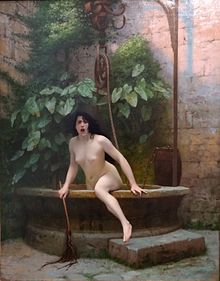The truth rises from the well
La Vérité sortant du puits armée de son martinet pour châtier lhumanité (French: Truth rises from the well, armed with its whip to chastise mankind ) is an allegorical painting by the French artist Jean-Léon Gérôme from 1896. The the official title was La verité (The Truth) .
Overview
From the mid-1890s, that is, during the last ten years of his life, Gérôme made at least four paintings depicting the truth as a naked woman. She is either thrown into a well, lies or stands at the bottom of a well, or steps out of a well. The subject of the pictures is based on an aphorism by the philosopher Democritus : "We know nothing of the truth, because the truth is in a well." (Greek: yτεῇ δὲ οὐδὲν ἴδμεν: ἐν βυθῷ γὰρ ἡ ήλήθεια, eteêi dè oudèn ídmen buthô gàr hē alḗtheia. ) The nudity of the female figure is also explained by the internationally used expression la vérité nue , “the naked truth”.
At the Champs Elysées Salon in 1895, Gérôme showed a painting entitled Mendacibus et histrionibus occisa in puteo jacet alma Veritas (Latin: Killed by liars and actors, the soul of truth lies in a well. ) It depicts the naked truth that was killed by the lie. The lie had first thrown her body into a well, on top of which a mirror, from which flashes of light shine, which illuminate the dark abyss.
In the next salon exhibition in 1896, Gérôme showed the allegorical truth as it rises from its fountain.

Both paintings (like a similar, later work by Edouard Debate-Ponsan ) were believed to be commentaries on the Dreyfus Affair , but art historian Bernard Tillier argued that Gérôme's Images of Truth and the Fountain were part of his ongoing feud against Impressionism .
In a foreword to Émile Bayard's The Nu Esthetics , published in 1902, Gérôme uses the metaphor of truth and the well to characterize the profound and irreversible influence of photography :
La photography est un art. La photographie force les artistes à se dépouiller de la vieille routine et à oublier les vieilles formules. Elle nous a ouvert les yeux et forcé à regarder ce qu'auparavant nous n'avions jamais vu, service considérable et inappréciable qu'elle a rendu à l'Art. C'est grâce à elle que la vérité est enfin sortie de son puits. Elle n'y rentrera plus. “Photography is an art. Photography forces artists to give up the old routines and forget the old formulas. She opened our eyes and forced us to look at what we had never seen before, doing a vast and invaluable service to art. It is thanks to her that the truth finally came out of her well. She will not return there. "
Gérôme kept at least one of the paintings in his private possession. When he died in 1904, “the maid found him dead in the small room next to his studio, slumped in front of a portrait of Rembrandt and at the foot of his own painting Truth .” The source for this event is an anecdote, but his biographer Moreau-Vauthier gives it does not indicate which painting is meant.
Since 1978 the painting has been part of the permanent exhibition at the Musée Anne de Beaujeu in Moulins . In 2012, after the painting was exhibited in Los Angeles, Paris and Madrid, the museum organized the exhibition La vérité est au musée “(The truth is in the museum”), in which numerous drawings, sketches and variants by Gérôme and other artists are collected related to the painting and its subject. The multiple interpretations of the painting's enigmatic meaning prompted one of the museum's curators to say: C'est notre Joconde à nous. ("This is our Mona Lisa .")
See also
Individual evidence
- ^ Fae Brauer: Rivals and Conspirators: The Paris Salons and the Modern Art Center . Cambridge Scholars Publishing, 2014, ISBN 978-1-4438-6370-4 ( com.ph [accessed June 25, 2020]).
- ↑ Diogenes Laertius. In: Lives of Eminent Philosophers. IX, 72. Perseus Project, Tufts University.
- ↑ Benoît Noël, Jean Hournon: Parisiana: la capitale des peintres au XIXème siècle. DISLAB. Paris 2006, ISBN 978-2-95272140-0 , p. 147. (French)
- ↑ Cecil Nicholson: The Academy . May 11, 1895, p. 408 f . ( Online [accessed July 8, 2020]).
- ↑ Gerald M. Ackerman: The life and work of Jean-Léon Gérôme: with a catalog raisonné. Sotheby's, 1986, ISBN 978-0-85667-311-5 , p. 276.
- ^ François Pouillon: Dictionnaire des orientalistes de langue française . Karthala Editions, 2012, ISBN 978-2-8111-0790-1 , pp. 466 (French, online [accessed July 8, 2020]).
- ^ Authors' exhibition of «La Vérité» by Jean-Léon Gérôme . January 18, 2012. Retrieved November 26, 2019.
- ↑ Bertrand Tillier. Gérôme et la vérité en peinture, Autour de la Vérité du Puits ... sortant . Regarder Gérôme, Musée d'Orsay, Paris December 2010.
- ^ Émile Bayard, preface v. Jean Léon Gérôme: Le Nu Esthétique. Bernard, Paris 1902.
- ↑ The Whirling Dervish .
- ^ As part of the traveling exhibition The spectacular art of Jean-Léon Gérôme.
- ↑ La vérité est au musée . 2012. Retrieved November 26, 2019.
Web links
- La Vérité est au musée - Press kit for the 2012 exhibition at the Musée Anne-de -Beaujeu (French)

